|
Need Help?
|
|
Call
1-800-372-3706
to
speak to a Veterinary Behavior Technician |
|
Paws To Speak!
Member
Main Menu
|

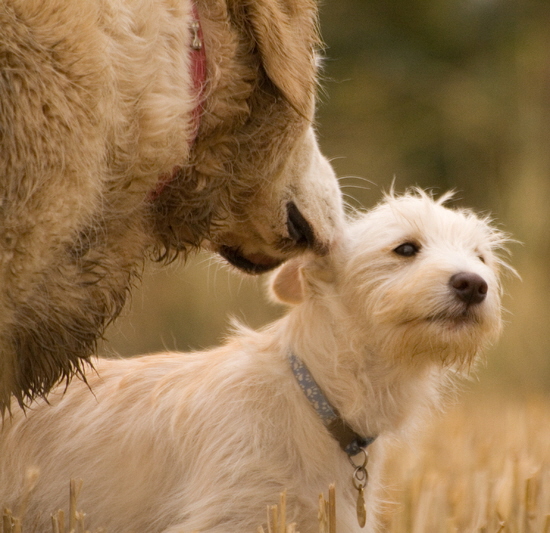
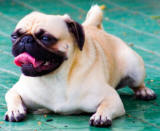
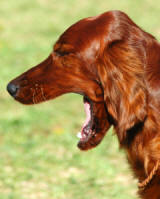
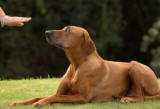
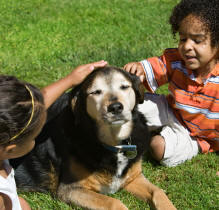
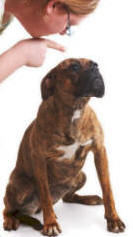
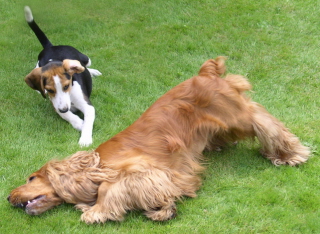
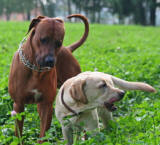
Famous Quote
"I talk to him when I'm lonesome and I'm sure he understands.
When he looks at me so attentively, and gently
licks my hands;
then he rubs
his nose on my tailored clothes,
but I never say a threat.
For the good Lord knows I can buy more clothes, but never
a friend like that!"
- W. Dayton Wedgefarth-
Video of Interest
Body Language
of Play in puppies |
300k |
56k |
|
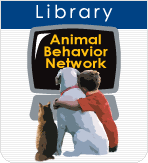 |
|
Help is at your
fingertips by library, email and
phone. |
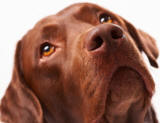
Click on
Library Icon
to learn more
|
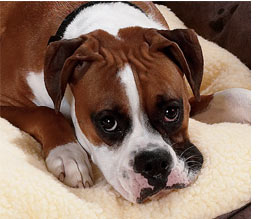 What
is Canine Communication? What
is Canine Communication?
Imagine this scenario. Your dog barks at something outdoors, waking you up. You
get up reluctantly, and tell your dog "stop" with clear annoyance in your voice
tone, staring at your dog feeling stiff from just waking up.
Your dog turns his head sideways and
licks his nose in one quick response. You grab the leash and your dog begins to
circle around in excitement.
You instruct, "Sit" so you can hook on the leash.
Your dog responds to your firm instructioning tone with a sit and yawn. On the walk, your
dog pulls a little on the leash.
You jerk him back and his nose goes to the
ground which annoys you so you jerk the leash again. Your dog lies down and
refuses to budge. After a few minutes, in a pleading voice you say, "Come on,
let's go," with your back to your dog. He gets up slowly and follows you.
You
arrive at the local dog park and let your dog off leash. As strange dogs
approach him, he turns his head sideways or slowly walks toward them in a curve.
Sometimes, he licks his nose and lies down. At other times, he freezes tail
straight out, head to one side and allows a dog sniffs his rear end.
|
Dogs use and read "calming signals" in order to avoid conflict. Although subtle,
you can learn to read and give these signals. |
What just happened?
You could have communicated better with
your dog.
Blessed are the peacemakers! Dogs share
a universal language, some communicating
better than others, with a natural goal
and behaviors to avoid conflict. Why on
earth would we ever threaten our dogs?
Sadly, people do not understand dogs and
how they communicate or how to
communicate to dogs in gentle, effective
body language.
Head turning
Dogs turn when uncomfortable
and to signal another dog to calm down.
A head turn is like a person saying,
"Uncle." A turned head averts a direct
gaze, Dogs give and understand a direct
gaze as a threat or challenge. Dogs turn
their heads to give polite, not "in your
face" greetings.
 |
Turn your head to the side when
you want to send a calming
signal to a dog.If a dog is
jumping up on you, turn to the
side and give no eye contact to
help calm your dog. |
Nose licking
Dogs signal with quick nose
licks or tongue flicks to help calm
themselves down or to send a calming
signal to others. When people lean over
or reach out to touch dogs, or when a
group of children approach the dog,
watch for a quick nose lick.
 |
If
your dog nose licks when you ask
for a sit, use a more neutral
voice tone. Dogs are eager to
please so instruct not instruction
or threaten your dog. You can
insist by gently placing your
dog in a sit position if your
dog ignores you.
Using a Gentle Leader head
collar is the easiest, safest
way to insist on a sit. |
Yawning
Dogs yawn when they feel
uncertain, stressed, a little scared or
worried. Dogs yawn when they are yelled
at or punished. Dogs yawn in the
veterinary exam room. Dogs yawn when
children hug them.
 |
Yawning contagious to people and
to canines. To help your dog
calm down, try yawning and see
if your dog yawns back.
|
 |
If a puppy gets too excited when
chasing a child and begins to
grab at the shoe laces or pant
legs, have the child stop and
yawn to help calm the puppy a
bit. |
Sitting and lying
down
Dogs will sit or lie down to help calm
another dog or situation. Sitting and
lying down are two ways dogs
respond to calm a threat or a perceived
threat.
 |
You are outdoors when a strange
dog begins charging your dog
from a distance. Turn your dog
away from the charging dog and
tell your dog to sit or lie down
to take the wind out of the
other dog's sails and help avert
a conflict.
|
Lovey eyes
Canines and felines respond positively
to "lovey eyes." Dogs and cats soften
their eyes by lowering the lids to
appear less threatening. In contrast, a
"whale eye" signals fear and stress.
 |
Use lovey eyes to calm cats or
dogs to signal friendly and
relaxed not a threat. |
Ears back
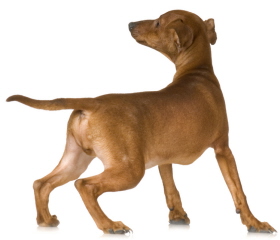 Canines and felines
put their ears back when unsure,
anxious, afraid or feeling threatened. Canines and felines
put their ears back when unsure,
anxious, afraid or feeling threatened.
The tail tells
Canines and felines put their tails
straight up when feeling confident. Dogs
are cats both twitch or wag their tails
in a stiff line at mid height when they
are annoyed and to signal a pending
threat. Happy tail wags are attached to
a wiggly, relaxed dog.
Move slowly
Canines move at a snails pace to send
calming signals
 |
Teach children to be still and
move very slowly to help a dog
relax around them. |
Sniffing
Canines put their noses to the ground to
calm another dog or person. It's as if
they are saying, "Don't mind me. I am
minding my own business." If you
call your dog using a harsh voice, your
dog's head may drop to the ground in a
sniffing gesture in response.
 |
If
your dog sniffs or lies down
when you call, make yourself
less threatening. Turn your back
or crouch to the ground with
open arms and use a cheerful
voice tone. |
Curving
Mature dogs rarely approach each other
straight on. Instead they make a wide
curve or arc to send a calming signal.
|
Try signaling an approaching dog who is
fearful by curving, sniffing, licking your lips, head turning, body
turning or sitting on the ground. |
Play bow
Dogs put the front legs down on the
ground with their rumps in the air to
release tension and show a friendly
greeting. When dogs play bow, especially
when jumping from side to side, they
want to play.
 |
Have some fun with your dog.
Imitate a play bow when you
start a game with your dog. Play
bow (in dog language) and watch
your dog's response. |
Pawing the air
Dogs paw at the air or paw
at you twhen they want your attention or
want to play. Dogs are confused when
people hit them because in dog language
pawing at the air is a friendly gesture.
 |
Teach your dog to "high five" or
"shake" as a positive outlet for
normal behavior.
|
|
"Dogs and wolves have strong instincts for conflict solving, communication and
cooperation." Turid Rugaas |
Pounce and retreat
Dogs like to play tag, too!
Pouncing and retreating means,
"Come on, chase me. It will be
fun!"
 |
Make sure to use a toy as the
obect of the chase game. You do
not want to teach your dog to
chase and grab at clothing,
shoes or hands.
|
Prancing, zig zagging and leaping in the air
Dogs prance, jump and zig-zag when they
are excited and happy. You can think of
this behavior as the dog literally
jumping for joy. So, why do people yell
or punish dogs for this normal, loving
expression?
 |
If
you want to calm your dog
without raining on his parade,
turn your side or back and
crouch down until your dog
settles.
|
 |
Reach out your hand and put a
thumb in the collar to keep your
dog back in a sit position as your
warmly greet your dog or hook on
the leash
|
|
An individual dog may show any combination of signals.
|
Rugaas, T. (2006). On talking
terms with dogs: Calming signals.
Wenatcchee, Washington: Dogwise
Publishing.
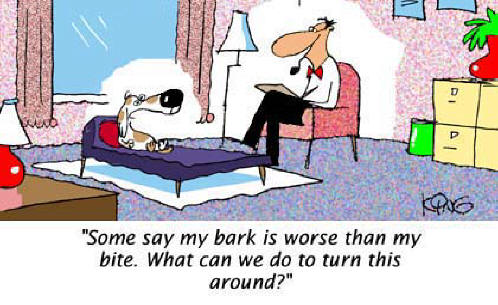
|